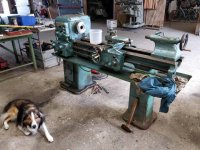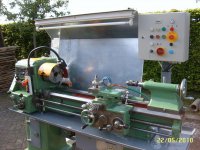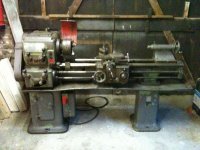So recently I acquired an old Rambaudi V(R)2 Mill (of which I will make a separate post) and this rather ancient WMW East German lathe.
As a background, I am not a machinist, but IT student and know very little of metalworking (but do have basic workshop experience). All I know is via either YT or reading on the internet, so please forgive any mistakes I've made or will make whilst working on these machines. Or any jargon I may get wrong.
When I got the lathe it was in poor working order, missing the gears on the z feed (for the feed rod and thread rod)and covered in 50 years of thick grease and oil.
The electric motor has been remounted by someone who added an electrical panel on the backside, but the engine is on rather crooked. This combined with the poor bearings on the motor means it makes a lot of noise and does not run properly. So far I've replaced one of the bearings and about to replace the other. The crookedness of the motor is already fixed mostly, although the v belts do still have some flapping. (Its a 380V 3 Phase motor, of I think 3kw)
It currently runs and I am figuring out the controls. Due to someone repainting the machine with this weird blue/aqua color, not all the levers have their descriptions remaining (actually just the ones on the carriage).
As you can see, so far I've figured out most of the controls, but am unclear as to what some of the handles do. The right most one of the z feed gearbox is seized currently.
The meanings of the two rows of numbers also isn't entirely clear, at least one seems to be the spindle speed as the lowest gear setting gives me about 50rpm.
The z feed gearbox is rather hard to open up (as far as I can see) so I haven't been able to see what the gears do.
I wonder if someone has any good idea on how to either figure out what they do or if they actually know how it works.
Lastly, I also don't quite understand the toolpost/toolholder. I haven't taken any proper pictures of it yet, but it looks like nothing I can find or the internet or properly understand by myself. The foot below the gearbox also lost a piece, but I may be able to weld it on, if the cast iron behaves.
I'll have to acquire an 160mm three jaw and some way to hold tools to start my first turning.
If I've made any mistakes by posting here, or if anyone wants to see something, I'm more than happy to comply.
As a background, I am not a machinist, but IT student and know very little of metalworking (but do have basic workshop experience). All I know is via either YT or reading on the internet, so please forgive any mistakes I've made or will make whilst working on these machines. Or any jargon I may get wrong.
When I got the lathe it was in poor working order, missing the gears on the z feed (for the feed rod and thread rod)and covered in 50 years of thick grease and oil.
The electric motor has been remounted by someone who added an electrical panel on the backside, but the engine is on rather crooked. This combined with the poor bearings on the motor means it makes a lot of noise and does not run properly. So far I've replaced one of the bearings and about to replace the other. The crookedness of the motor is already fixed mostly, although the v belts do still have some flapping. (Its a 380V 3 Phase motor, of I think 3kw)
It currently runs and I am figuring out the controls. Due to someone repainting the machine with this weird blue/aqua color, not all the levers have their descriptions remaining (actually just the ones on the carriage).
As you can see, so far I've figured out most of the controls, but am unclear as to what some of the handles do. The right most one of the z feed gearbox is seized currently.
The meanings of the two rows of numbers also isn't entirely clear, at least one seems to be the spindle speed as the lowest gear setting gives me about 50rpm.
The z feed gearbox is rather hard to open up (as far as I can see) so I haven't been able to see what the gears do.
I wonder if someone has any good idea on how to either figure out what they do or if they actually know how it works.
Lastly, I also don't quite understand the toolpost/toolholder. I haven't taken any proper pictures of it yet, but it looks like nothing I can find or the internet or properly understand by myself. The foot below the gearbox also lost a piece, but I may be able to weld it on, if the cast iron behaves.
I'll have to acquire an 160mm three jaw and some way to hold tools to start my first turning.
If I've made any mistakes by posting here, or if anyone wants to see something, I'm more than happy to comply.








